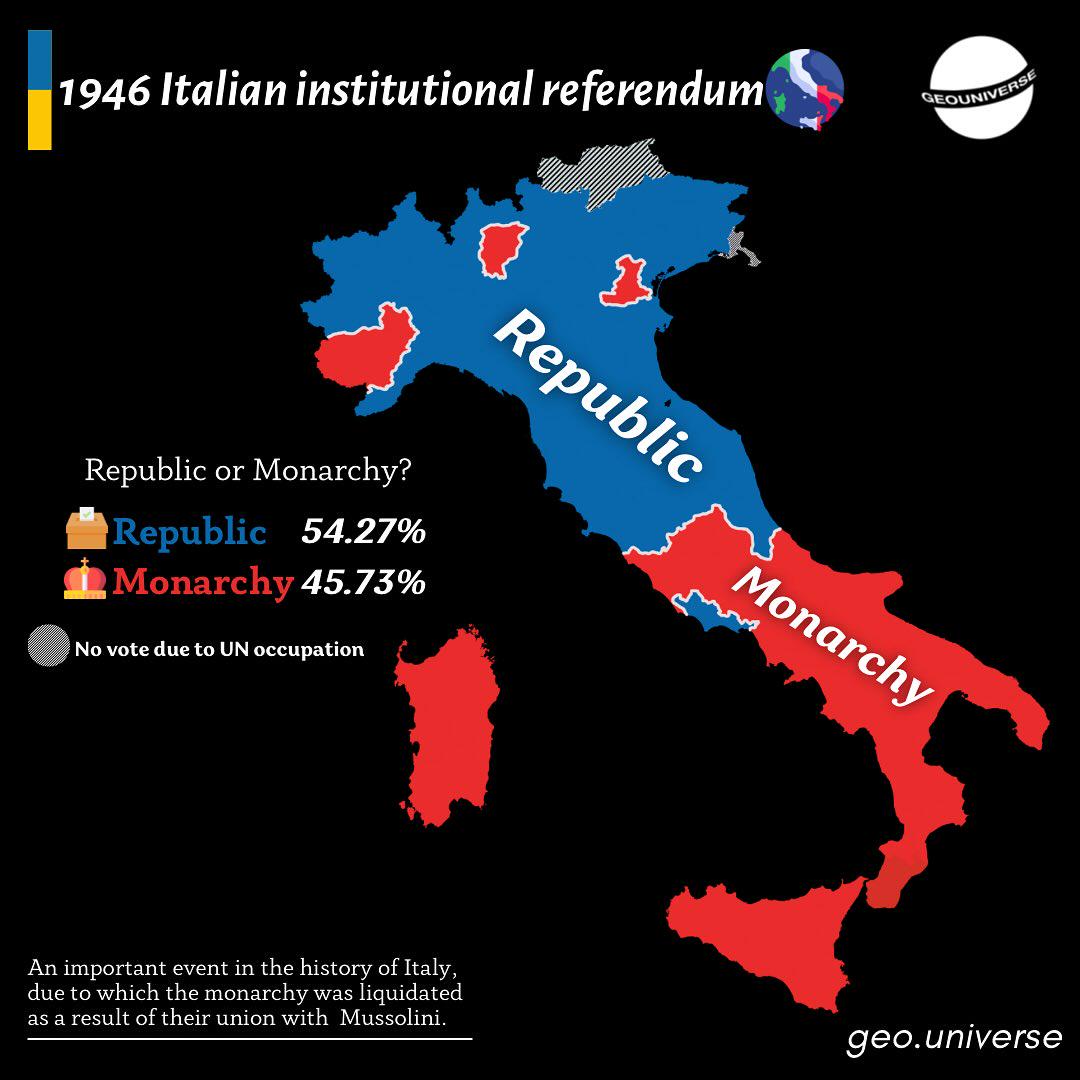1946 Italian Referendum Results Map


Marcus Rodriguez
Historical Geography Expert
Marcus Rodriguez specializes in historical cartography and geographic data analysis. With a background in both history and geography, he brings unique...
Geographic Analysis
What This Map Shows
The 1946 Italian Referendum Results Map vividly displays the outcomes of a pivotal moment in Italy's history: the referendum held on June 2, 1946, which determined the future of the Italian state following World War II. Citizens were faced with a crucial decision: to choose between a monarchy and a republic. The map highlights the various regions of Italy, color-coded to indicate the percentage of votes for each option. This visualization not only captures the geographical distribution of preferences but also reflects the diverse political sentiments across the nation during a time of significant social and political transformation.
Deep Dive into the Italian Referendum
The 1946 referendum was monumental as it marked the end of the monarchy that had ruled Italy for decades. Following the downfall of Mussolini's fascist regime and the subsequent liberation of Italy, there was a strong desire for change. The referendum saw approximately 12 million Italians vote for a republic, while around 10 million favored the monarchy. This shift towards republicanism symbolized a broader rejection of authoritarianism and a yearning for a democratic future.
Interestingly, the voting patterns were not uniform across the country. Regions with strong historical ties to the monarchy, such as the South, tended to favor retaining the monarchy, while the North, having experienced more direct impacts from the war and fascism, leaned more towards establishing a republic. For instance, the results indicate that regions like Campania and Sicily showed significant support for the monarchy, whereas areas like Emilia-Romagna and Tuscany were predominantly in favor of the republic.
The referendum's implications went beyond merely choosing a form of government. It also catalyzed the drafting of a new constitution, which was adopted in 1948, laying the groundwork for Italy's current democratic framework. The constitution enshrined fundamental rights and freedoms, addressing the public's desire for a more inclusive and participatory political environment.
Moreover, the referendum was a landmark moment for women's rights in Italy. Women gained the right to vote for the first time in this referendum, marking a significant step towards gender equality in a country that had previously marginalized female political participation. The map thus serves as a historical snapshot of not only political preferences but also social progress.
Regional Analysis
Delving deeper into the regional results, we can observe intriguing patterns. For instance, the northern regions of Italy, particularly Lombardy and Veneto, demonstrated a decisive shift towards republicanism, reflecting their industrialized and urbanized demographics. The urban centers in these areas were more exposed to progressive ideas and reforms, which likely influenced their voting behavior.
Conversely, in central and southern regions like Lazio and Calabria, the monarchy received substantial support. This can be attributed to cultural and historical factors, including loyalty to the Savoy dynasty. Interestingly, these regions had different socio-economic contexts, with many areas still grappling with poverty and a slower pace of modernization, which may have contributed to their preference for the traditional monarchy.
The map also reveals that the regions of Trentino-Alto Adige and Friuli Venezia Giulia had mixed results, showcasing a more nuanced perspective due to their unique ethnic backgrounds and historical ties to various Empires. This divergence in voting behavior underscores the complexity of Italian identity and regionalism, which continues to play a role in Italy's politics today.
Significance and Impact
The significance of the 1946 referendum extends far beyond its immediate results. It set a precedent for democratic governance in Italy and provided a framework for political engagement that resonated with the populace. The establishment of the republic was a testament to the resilience of the Italian people in the face of adversity, and it paved the way for Italy's integration into European political structures post-war.
Currently, the legacy of this referendum is evident in Italy's political landscape, which continues to grapple with issues surrounding governance, regional autonomy, and the balance between tradition and modernity. As Italy approaches the centenary of this historic decision, discussions surrounding national identity and the role of citizens in shaping governance remain as relevant as ever. The 1946 Italian Referendum Results Map not only documents a historical moment but also serves as a reminder of the ongoing journey of Italian democracy and the importance of civic engagement.
Visualization Details
- Published
- October 20, 2025
- Views
- 52
Comments
Loading comments...